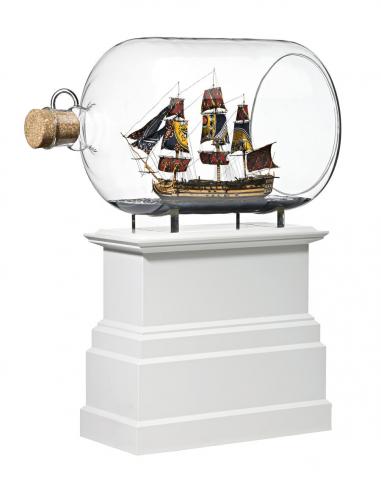NELSON'S SHIP IN A BOTTLE, 2007
YINKA SHONIBARE
plastic, Dutch wax printed cotton textile, cork, acrylic and glass bottle
41.0 x 65.0 x 38.0 cm
height including plinth: 86.0 cm
Anna Schwartz Gallery, Sydney
Company collection, Sydney
This work is a maquette for the major installation, Nelson's Ship in a Bottle, 2010, The Fourth Plinth, Trafalgar Square, London, May 2010 – January 2012, now in the collection of the National Maritime Museum, Greenwich, United Kingdom
'I feel that art is a form of alchemy. You can take control of your own image, of your own life.'1
Often irreverent but always playful, the creations of Yinka Shonibare are arguably among the most provocative, witty and original of his generation. Encompassing a true cornucopia of media from painting, sculpture and film to performance and installation, his rich and colourful oeuvre powerfully disrupts established notions of cultural and national identity in a globalised society, interrogating the legacy of colonialism alongside more universal issues of race and class. Drawing upon episodes of post-Renaissance European art (especially Classicism, Rococo and Romanticism) for his elegant, theatrical and sometimes darkly humorous incarnations, Shonibare thus poignantly juxtaposes both historic and contemporary symbols and paradigms, offering a critical tour of Western civilisation while simultaneously revealing the enormous complexity that defines our time.
Describing himself as a 'postcolonial hybrid', Shonibare was born in England in 1962, moved to Nigeria three years later, and eventually returned to London to study Fine Art first at Byam Shaw College of Art (now Central Saint Martins College of Art and Design) and then at Goldsmiths College, where he received his Masters of Fine Art. In 2002, he was famously commissioned by Okwui Enwezor at Documenta XI to create the widely acclaimed 'Gallantry and Criminal Conversation' installation that served to launch his career internationally - a controversial piece which, featuring his signature headless mannequins dressed in period costume, explores the rampant immorality and violence underlying colonial and imperial socio-political order. Selected as a Turner Prize nominee in 2004, Shonibare was awarded the Member of Order of the British Empire the following year, and in 2008, his achievements were celebrated with a major mid-career survey 'Yinka Shonibare MBE' which commenced at the Museum of Contemporary Art, Sydney and subsequently toured to venues in New York and Washington (2008-2010).
The maquette for his major installation commissioned specifically for the Fourth Plinth in Trafalgar Square, London, Nelson's Ship in a Bottle, 2010 encapsulates well the artist's abiding preoccupation with themes of colonialism, industrialisation and emigration. Reflecting upon the symbolism of Trafalgar Square, which commemorates the Battle of Trafalgar and links directly with Nelson's Column, the work is an exact replica of Nelson's battleship, HMS Victory, with 80 cannon and 37 sails set as on the day of the Battle, 18 October 1805, when he died. Alluding to processes of cultural appropriation and the invention (and re-invention) of tradition, the opulently patterned textiles, however, constitute a deliberate departure from the original. Inspired by Indonesian batik design, such fabrics - which were mass-produced by the Dutch and sold to colonies in Central and Western Africa - are today, paradoxically, associated with African identity and independence. Thus, powerfully highlighting the often ambivalent, tangled interrelationship between Africa and Europe in their respective economic and political histories, Nelson's Ship in a Bottle not only initiates discussion of Britain's past as an imperial power, but importantly, also celebrates the rich multiculturalism and ethnic diversity of the country's present; as the artist himself muses,
'For me, it's a celebration of London's immense ethnic wealth, giving expression to and honouring the many cultures and ethnicities that are still breathing precious wind into the sails of the United Kingdom. A ship in a bottle is an object of wonder. Adults and children alike are intrigued by its mystery. How can such towering masts and billowing sails fit inside such a commonplace object?'2
1. Shonibare quoted in Milliard, C., 'Same but Different', Catalogue Contemporary Art Magazine, Issue 1, 2010
2. Shonibare quoted on his website <http://www.yinkashonibarembe.com/press/past/hmsvictory-returns-to-trafalgar/>
VERONICA ANGELATOS
